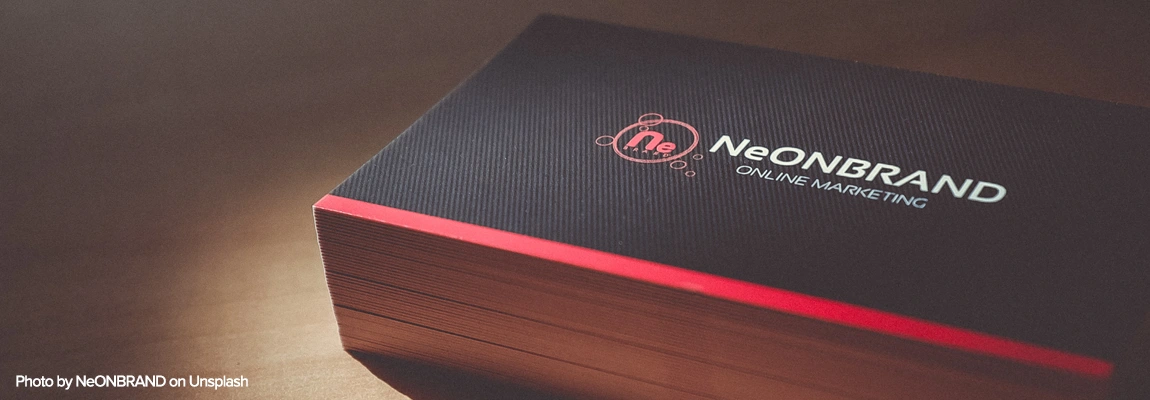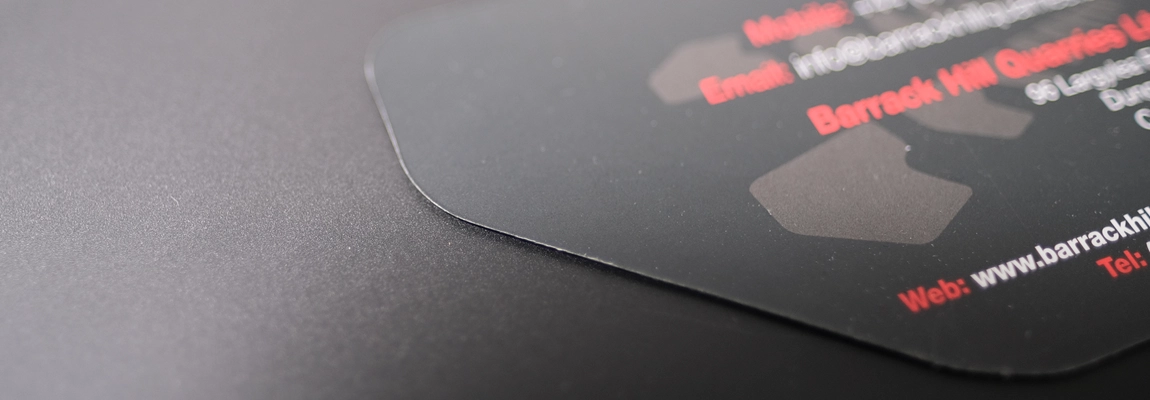6 Great Finishing Options for printed Business Cards
6 Great Finishing options for Printed Business Cards

While you may think of a business card as a plain rectangular card with your contact information, it is now an important part of building your portfolio and presenting your skills. Think of it as a pocket-sized billboard that meets all of your professional requirements, including boosting advertising, brand awareness, plus sharing contact information. These small cards are great assets that help turn a passing stranger into a potential valuable client.
This is especially true now that handshakes are quickly becoming things of the past in the Covid era. Your business card can still help make a distinct first impression. They represent not only your company but also your professional identity. This makes it important to take all possible measures to ensure that your card helps create long-term relationships with your clients and partners instead of ending up in a recycling bin.
When it comes to building your personal brand, it's no longer enough to just hand out a business card with your name and phone number on it. One contemporary strategy is to make your business card highly appealing by using the right finish. Read on to learn about different business card finishes to find the one that works best for you and help your business card stand out in the crowd.
Five Types of Business Card Finishes
Business cards today are vastly different from those of ten years ago. Design is very much in, and plain cards with just the basic typography are considered obsolete and worthless. You need a custom print finish to give your card that extra, distinctive touch and create a more memorable customer connection.
While you can alter and customise it to fit your business, there are some surface finishes that can help your design stand out even more. Let's take a look at them.

1. Folded Business Cards
Why settle for a flat business card when a single fold card may provide you with twice the amount of area for your information and personalisation?
When there is a lot of information to provide these can also be used as Appointment cards — if the material is preferably an Uncoated board finish (see below), to allow you to keep track of your customers' appointments. At the growing range of trade events, post-Covid, attendees are handed dozens of company cards at a time. A Folded version will be a "keeper" and one potential clients will remember.
However, if you're utilising a folded design, it is best to not coat them at all and a 350gsm Uncoated board if the ideal way to go otherwise most pens will smudge if there’s lamination etc., with exception to Sharpie pens. It's still vital to utilise a conventional 85mm x 55mm size (once folded) in most wallet’ credit card slots, so an opened card will be a double-sided, 170mm wide canvas.
2. Die-Cut Shaped Business Card
Die-cut business cards are a proven method to catch people's attention. The majority of UK printing companies offer pre-made dies that may be used to cut your artwork into a specified shape, although remember to think about how much room you'll have left for your contact information.
Some die cut templates eliminate a significant amount of the canvas area, leaving you with significantly less room to communicate with. Don't just cut shapes out of your business card at random; they should have a purpose e.g. if you're a dentist, artwork in the shape of a tooth might well be appropriate.
Many pre-made die shapes (e.g. circles and rounded corners) are readily available at printing firms. If the shape you desire isn't available, you'll likely have to spend more to have the die custom-manufactured at a small extra cost.

3. Foil Stamping Finish
Foil stamping is a popular treatment that adds a touch of beauty to your business card. This finish draws emphasis to the most prominent feature on your business card. It will give your project a reflected aspect and a touch of luxury and sleekness.
Foil stamping isn’t that expensive any more compared to a decade ago, but it's an excellent way to make specific components of your business card stand out and grab the receiver's attention within seconds. The basic foil material used is remarkably similar to aluminium foil commonly used in the kitchen.
To make the business card stick, a tiny layer of foil is pushed onto it with heat. The crushed object seems somewhat sunken and debossed result as the foil is firmly pushed in place.
It gives the business card a really elegant appearance. Some companies have the technical capability to print a translucent ink on top of standard silver foil to emulate nearly any colour imaginable, allowing tints of gold, copper and anything your design requires.
4. Embossed / Debossing Finish
Embossing gives your text, graphic, or design a 3D effect, thus elevating your card to the next level. You don't want your prints to rise, do you? Debossing produces the reverse effect, in which the paper is pressed in rather than springing out, but the 3D look is maintained.
An embossed logo on a business card is a good method to make your logo stand out from the rest of the card and give it a more textured feel. Embossing or debossing does not lend a gleam to the raised feature. It will have the same appearance as before, except that it will be raised slightly above the level of canvas.
When embossing an area of your artwork canvas, keep in mind that it will have a debossing impact on the reverse side of the card. This can be a problem if you plan on using both sides of your business card. It's better to utilise the letter pressing approach if you only want to emboss one side of your business card.
5. Spot UV Varnish
A Spot UV treatment allows a business card to pop-up significantly from the rest of the card with a shiny, glossy element overlaid on top of specific logos, photos or other elements, allowing you to choose a design focal point, that you want your recipients to notice more than the rest.
It adds a coat of gloss varnish to your card which brings out the deeper colours whilst enhancing the saturation of the design. This finish will give your new card an up-market, professional appearance.
As there’s no embossing, Spot UV allows you to utilise both sides of the card.

6. Lamination
Laminating the basic Silk Artboard of a business card allows the design to be sealed in, giving a luxuriously silky-smooth finish with the Matt Laminated version, helping it withstand scuffs, scratches and wear & tear, including oily or dirty hands etc.; Laminated finishes are usually applied to both sides of a design.
Matt Lamination is usually added to an industry standard-sized Luxury Business Card of 85mm x 55mm that’s printed on either 400gsm or more likely 450gsm Silk Artboard in the modern era.
Two other advantages of Matt Lamination are that it can be written on, either with a ball-point pen or Sharpie marker, and they don’t reflect light so slightly easier to read, especially outside in the daylight.
The one down-side to lamination due to its plastic nature is that it’s not currently recyclable.
Design & Print your Business Cards with TradePrintingUK
When you're ready to start designing your own business cards, reach out to Trade Printing UK to explore the best options, including their best seller — the Luxury Business Card. They offer free online templates to get you started if you don't have a design in mind and can also help you find the perfect custom print finishes.
You can also try our amazing new MAGNETIC business cards that adhere to any metal surface. Contact them to discuss your design and finish or receive a free quote.